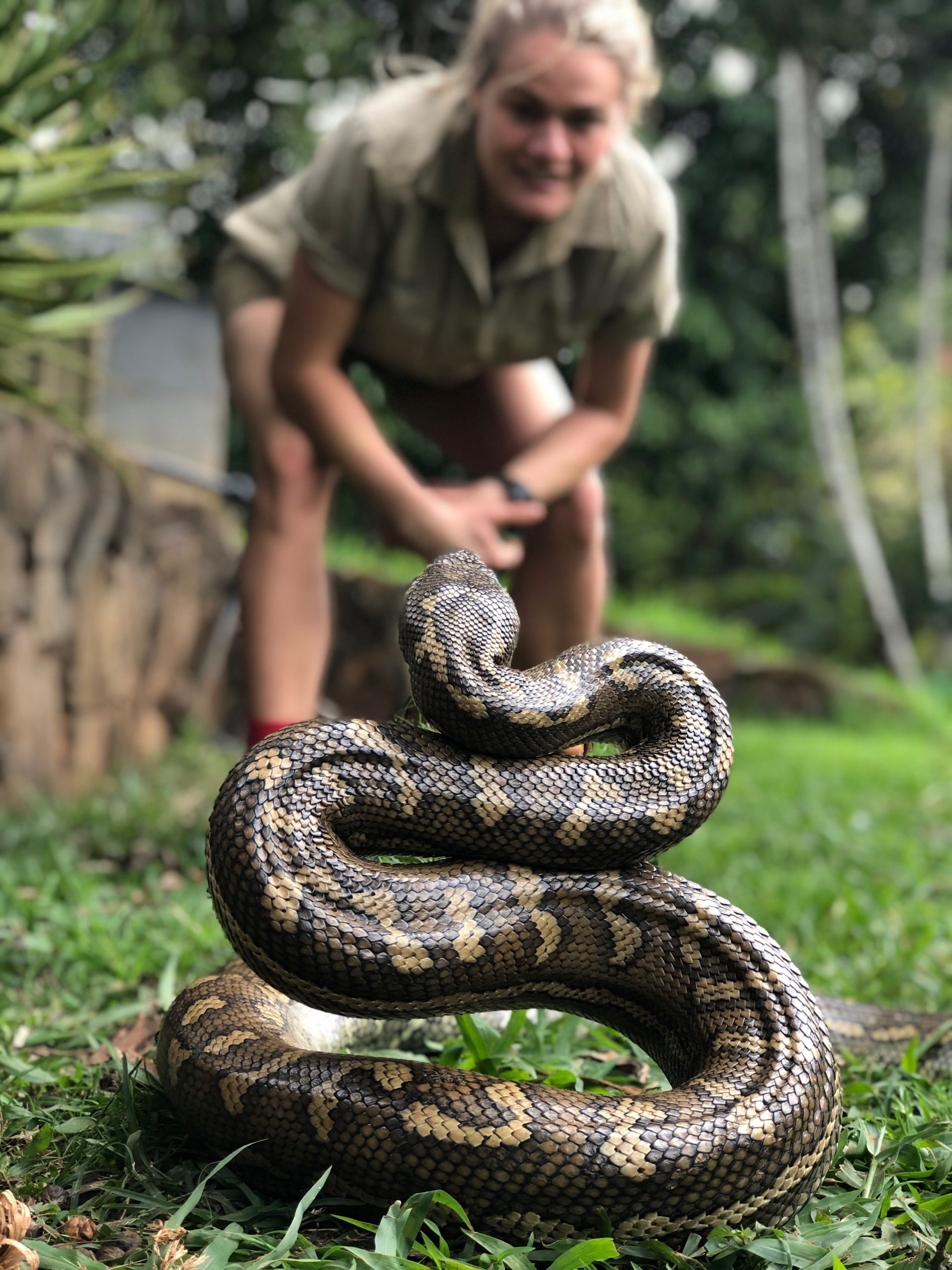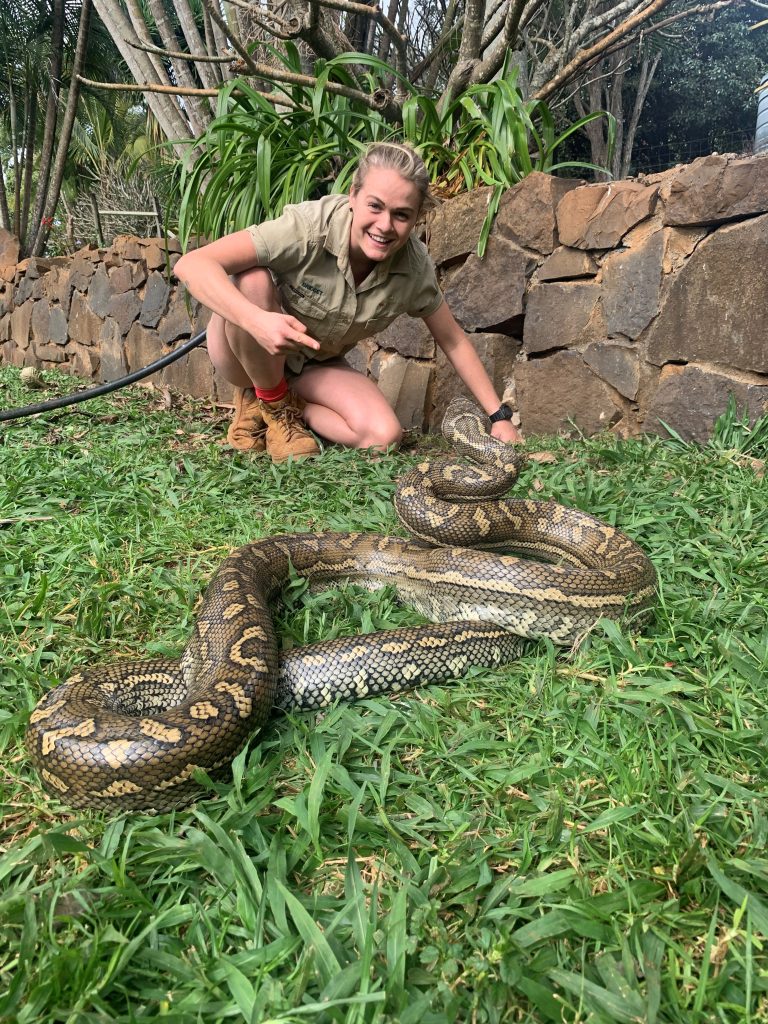
Snakes are active in the Byron Shire throughout the warmer months, and it’s important to be aware of what species are around and what to do if you see one, writes Angela Saurine.
If you’ve lived in the Northern Rivers for a while, chances are you’ve seen a snake of some kind slithering around. The reptiles are abundant throughout the region, with sightings more common in the warmer months when they are out and about looking for food and mating. Byron Bay Wildlife Hospital associate veterinarian Dr Chantal Whitten says several species of snake can be found in the Byron Shire, with the coastal carpet python the most common. “Last month we saw 17 of these snakes at our hospital,” she says. “They were mostly hit by a car or injured by lawn mowers and whipper snippers.” Green tree snakes, also known as common tree snakes, are also common. “The venomous ones to watch out for are red-bellied black snakes and eastern brown snakes,” Dr Whitten says. She says snakes usually hang around where there is food and shelter. “They seek refuge under wood and tin and try to steal eggs and chickens,” she says. If you see a snake, Dr Whitten says the best thing to do is leave it alone. “They are just as scared of us,” she says. If you are unsure if it is venomous, she recommends calling a snake catcher to relocate it. If it’s injured, call WIRES or Northern Rivers Wildlife Carers, who will send an experienced handler to collect it and take it to the hospital for treatment. “We can do some things to help protect them, like not using rodenticide to bait mice and rats as snakes can get secondary poisoning, and checking the lawn for snakes before mowing,” Dr Whitten says.

Marion Nel, from Safe Snake Services, says if you come across a snake in your home, try to lock it in the room you saw it so it’s easier for the snake catcher to locate, and place rolled up towels under doors to stop it escaping. “If your house is open plan, keep a safe distance while keeping an eye on it,” she says. Marion says snakes are often found in bird aviaries and other animal enclosures. “Check your mouse-proofing,” she recommends. “If it’s mouse and rat-proof, it’s snake-proof.”
While she hasn’t necessarily seen more snakes than usual this season, Marion says they seem to be bigger this year. “It’s like they’ve had a good food season last year so they’re all busting at the seams,” she says.
Originally from South Africa, Marion has always had a love of animals and started volunteering with WIRES after moving to McLeans Ridges. “I decided to do snake training as I kept coming across snakes needing help and had my own scary python encounter when one got inside my bird cage and I had no idea what to do,” she says. “One year later I was catching snakes, two years later I was reptile cocoordinator for WIRES, and I’m currently in my third season of private snake catching.”
Marion says we live with snakes safely most of the time. She says to make sure you look wherever you put your hands or feet in the garden to avoid stepping on one. Eastern brown snakes, she says, have the potential to kill a large human with one bite. “Their venom is the second most toxic in the world,” she says. “I’ve seen a really angry brown and it’s not like a normal brown snake giving you a warning, it’s hardcore defensive behaviour with intent to kill when you’ve really upset one and I believe if they wanted to harm us handlers, they would. Red-bellied black snakes are dangerously venomous, but not nearly as dangerous as eastern browns. Snake catchers love red-bellied black snakes because they’re cooperative, beautiful and an impressive snake. They’re amazingly adept at finding their way out of a house if they accidentally get trapped inside. They just need space and time to get away.”
Marion says dogs are by far the biggest problem when it comes to snake safety. “It’s a tough one if the dog is hellbent on finding the snake, but once you’re aware of the danger you have to do whatever you can to prevent an altercation,” she says. “If you’re getting a puppy there are training programs for snake safety, so contact your vet.” Knowing the local snake species is important, Marion says, and every household should have a couple of pressure bandages stored somewhere easy to find and know how to use them in case someone gets bitten. “Always call 000 after applying first aid,” she says. Ballina-based Bridget Thomson, who is one half of The Wildlife Twins, began working as a snake catcher after studying a Bachelor of Applied Science majoring in wildlife science at the University of Queensland, before moving into wildlife education with her sister Sophie. She says 85 per cent of snake bites occur when someone is trying to catch, kill or handle a snake. If you find yourself within one to two metres of a snake, Bridget says to stay still and wait for the snake to move on. “Snakes have terrible vision,” she says.
“Most snakes in Australia can only see about two or three metres, so they react to movement. Even if the snake was startled, just stay calm, stay still, and the snake will move on.” Bridget says that if it’s a hot and windy day, it’s also likely to be an active snake day. “They feel safer moving out in the open when there’s a lot of foliage blowing around as predators like birds can’t spot them as easily,” she says. Snakes, Bridget says, play an important role in the environment and don’t want to hurt us. “I don’t want to scare anyone, but for every snake that you see, there’s probably another 10 around that you didn’t see. We need to respect them.”